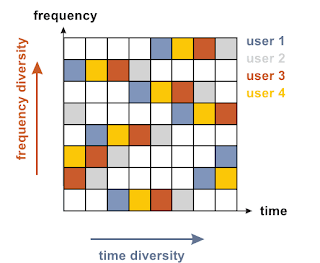Orthogonal Frequency Division Multiplexing (OFDM) is a technique for transmitting large amounts of digital data over a radio wave The technology works by splitting the radio signal into multiple smaller sub-signals that are then transmitted simultaneously at different frequencies to the receiver. OFDM reduces the amount of crosstalk in signal transmissions.
OFDMA is a multi-user OFDM that allows multiple access on the same channel (a channel being a group of evenly spaced subcarriers).
OFDMA distributes subcarriers among users so all users can transmit and receive at the same time within a single channel on what are called subchannels. What’s more, subcarrier-group subchannels can be matched to each user to provide the best performance, meaning the least problems with fading and interference based on the location and propagation characteristics of each user.
OFDMA is a multiplexing technique that subdivides the bandwidth in to multiple frequency sub-carriers. Here the input data stream is divided in to several parallel sub-streams of reduced data rate and each substream is modulated and transmitted on a separate Orthogonal Subcarrier.
It is a multi-user version of the popular orthogonal frequency division multiplexing [ OFDM ] digital modulation scheme. Multiple access is achieved in OFDMA by assigning subsets of subcarriers to individual users.
The main advantages of OFDMA over TDMA/CDMA stem from the scalability of OFDMA, the uplink orthogonality of OFDMA and the ability of OFDMA to take advantage of the frequency selectivity of the channel. Other advantages of OFDMA include its MIMO-friendliness and ability to provide superior quality of service (QoS).
OFDMA Advantages
- Averaging interference's from neighboring cells, by using different basic carrier permutations between users in different cells.
- Interference’s within the cell are averaged by using allocation with cyclic permutations.
- Enables orthogonality in the uplink by synchronizing users in time and frequency.
- Enables Multipath mitigation without using Equalizers and training sequences.
- Enables Single Frequency Network coverage, where coverage problem exists and gives excellent coverage.
- Enables spatial diversity by using antenna diversity at the Base Station and possible at the Subscriber Unit.
- Enables adaptive modulation for every user QPSK, 16QAM, 64QAM and 256QAM. Enables adaptive carrier allocation in multiplication of 23 carriers = nX23 carriers up to 1587 carriers (all data carriers).
- Offers Frequency diversity by spreading the carriers all over the used spectrum. Offers Time diversity by optional interleaving of carrier groups in time.

No comments:
Post a Comment